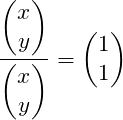Vektoren haben immer eine Länge und Richtung und werden als Pfeil bezeichnet ![]() . Vektoren sind teil der Trigonometrie
. Vektoren sind teil der Trigonometrie
Vektorielle Größen
- Kraft

- Geschwindigkeit

- Beschleunigung

- Impuls

Vektorschreibweise
(1) 
Dieser 2-dimensionale Vektor besteht aus zwei Komponenten ![]() und
und ![]() .
.

Rechenoperationen
Addition
(2) 
Subtraktion
(3) 
Multiplikation
(4) 
Division
(5) 